Uninstall ODCODC Ransomware virus (Jan 2017 updated) - Bonus: Decryption Steps
ODCODC Ransomware virus Removal Guide
Description of ODCODC Ransomware virus
What should you know about ODCODC virus?
ODCODC virus is the file-encrypting malware is not as dangerous as its developers wanted it to be. Using various distribution techniques, it infiltrates computers and starts data encryption. It uses an RSA-2048[1] cipher, appends .odcodc file extension and includes an email address to all target files names. ODCODC ransomware informs victims about data encryption by delivering a ransom note called readthis.txt. In the message, hackers try to scare and convince people that data decryption is impossible without unique decryption key that is stored in the Command and Control server. One the one hand, they tell the truth – the key is necessary; on the other, there’s no need paying some Bitcoins for this key. Cyber security researcher BloodDolly managed to crack malware’s code and launched a free decryption tool. Therefore, if you got infected with this ransomware, you should not worry about data loss. Start with ODCODC removal and finish with simple data recovery solution.
The ransom message is written in two languages – English and Russian. It seems that developers of the ODCODC virus had big ambitious to target a broad audience of computer users. However, the hackers do not reveal the size of the ransom. The amount of money might vary depending on the number of targeted files or their importance. Victims are asked to contact cyber criminals via email abennaki@india.com or ranscript@india.com and wait for the response. Sonner or later hackers send instructions how to pay the ransom and get back personal files. However, as you already know, there’s no need to contact cyber criminals and transferring the money. ODCODC ransomware virus is decryptable, so you should concentrate on its removal first. When dealing with ransomware, it’s important to use professional and reputable tools to eliminate malware with all its malicious components. Getting rid of the virus manually is not recommended, so you have to do it automatically. For ODCODC removal we recommend scanning device with FortectIntego or SpyHunter 5Combo Cleaner. We want to remind you that not all ransomware attacks end up good because not all of them are decryptable. For this reason, it’s crucial to think about data backup solutions because chances to encountering file-encrypting virus are higher than ever[2].

Ways to get infected with ransomware
Talking about ODCODC malware distribution techniques, they do not differ from other ransomware infiltration methods. Starting from malicious email attachments and finishing with Trojans, ransomware spreads using all possible ways to trick computer users and infect their computers. The bigger chances to encounter ODCODC ransomware is to open a malicious email[3] attachment that looks like the legitimate and safe document. Bear in mind that nowadays hackers are good at their job and learnt how to disguise infected components. Therefore, before opening any suspicious email received in your inbox, you should think twice about possible consequences. Furthermore, you should not rush clicking on eye-catching ads and other links received or found on the Internet. They might include malicious files or lead to the infected websites. Malware might also spread as a Trojan horse and use exploit kits[4] to infiltrate the system. For this reason, you should protect your PC with a reputable anti-malware program and keep all software updated. Without putting some effort[5] and thinking about your behaviour online, you might lose your data, money or even identity.
ODCODC removal instructions
Earlier we mentioned that manual ODCODC removal is restricted. This computer infection is complicated and deleting virus-related components is nearly impossible without any help. We recommend getting rid of the malware using one of these tools – FortectIntego, SpyHunter 5Combo Cleaner or Malwarebytes. Of course, you can also choose your preferred software, but don’t forget that free antivirus utilities won’t work in this case. The virus might not let remove ODCODC easily; however, you can beat its defence by following our prepared instructions below. As soon as your PC is virus free, you can use ODCODC decryption tool and restore lost files.
Getting rid of ODCODC Ransomware virus. Follow these steps
In-depth guide for the ODCODC Ransomware elimination
If ODCODC Ransomware blocks access to your chosen malware removal program, you have to reboot your PC to the Safe Mode with Networking. The instructions presented below will help you to install or run the software and remove the infection.
Important! →
The elimination guide can appear too difficult if you are not tech-savvy. It requires some knowledge of computer processes since it includes system changes that need to be performed correctly. You need to take steps carefully and follow the guide avoiding any issues created due to improper setting changes. Automatic methods might suit you better if you find the guide too difficult.
Step 1. Launch Safe Mode with Networking
Safe Mode environment offers better results of manual virus removal
Windows 7 / Vista / XP
- Go to Start.
- Choose Shutdown, then Restart, and OK.
- When your computer boots, start pressing the F8 button (if that does not work, try F2, F12, Del, etc. – it all depends on your motherboard model) a few times until you see the Advanced Boot Options window.
- Select Safe Mode with Networking from the list.
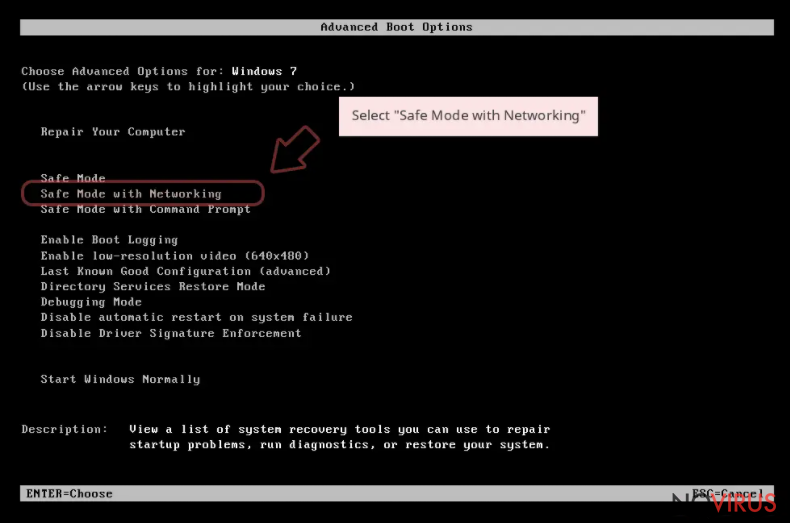
Windows 10 / Windows 8
- Right-click the Start button and choose Settings.
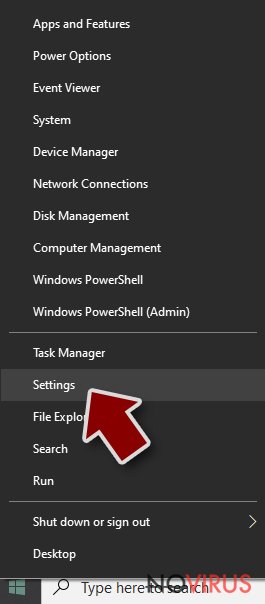
- Scroll down to find Update & Security.
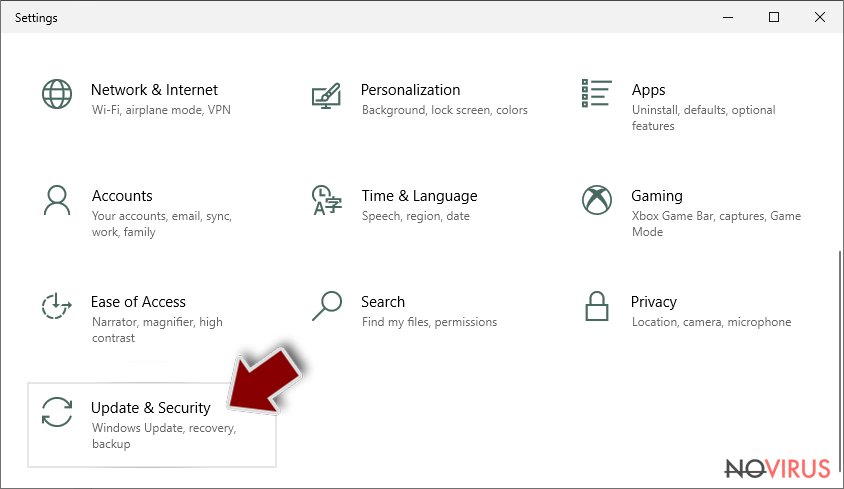
- On the left, pick Recovery.
- Scroll to find Advanced Startup section.
- Click Restart now.
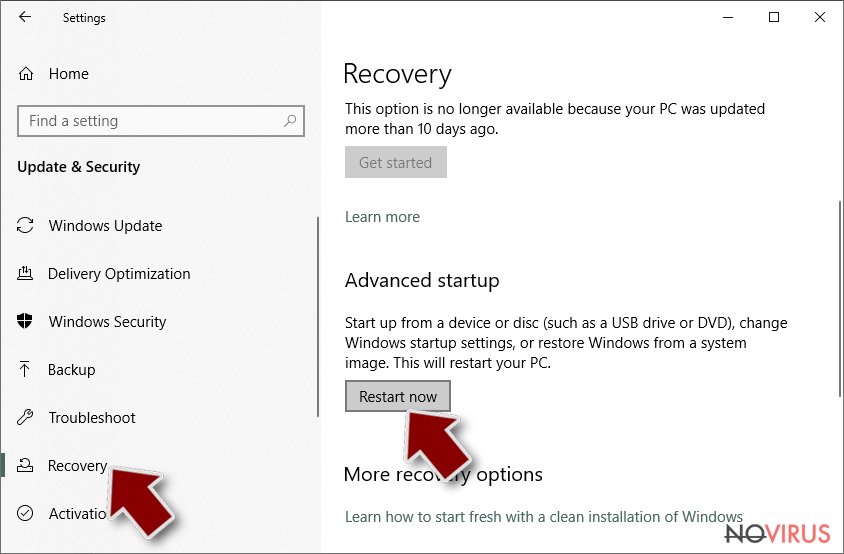
- Choose Troubleshoot.
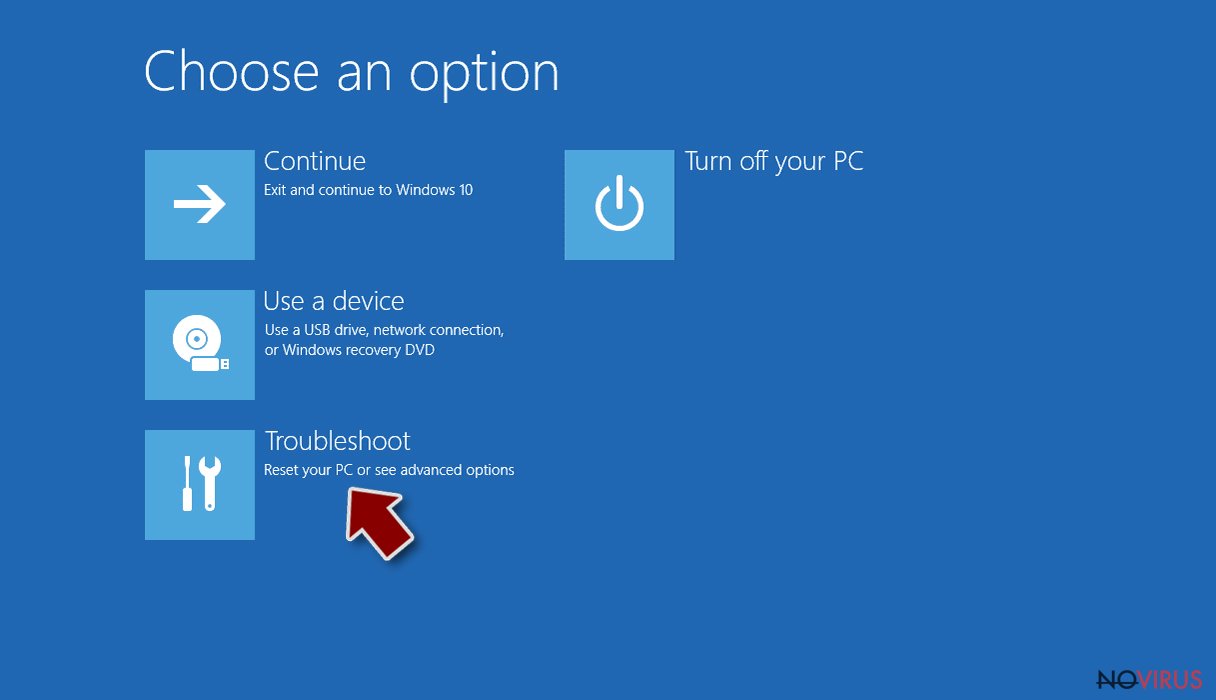
- Go to Advanced options.
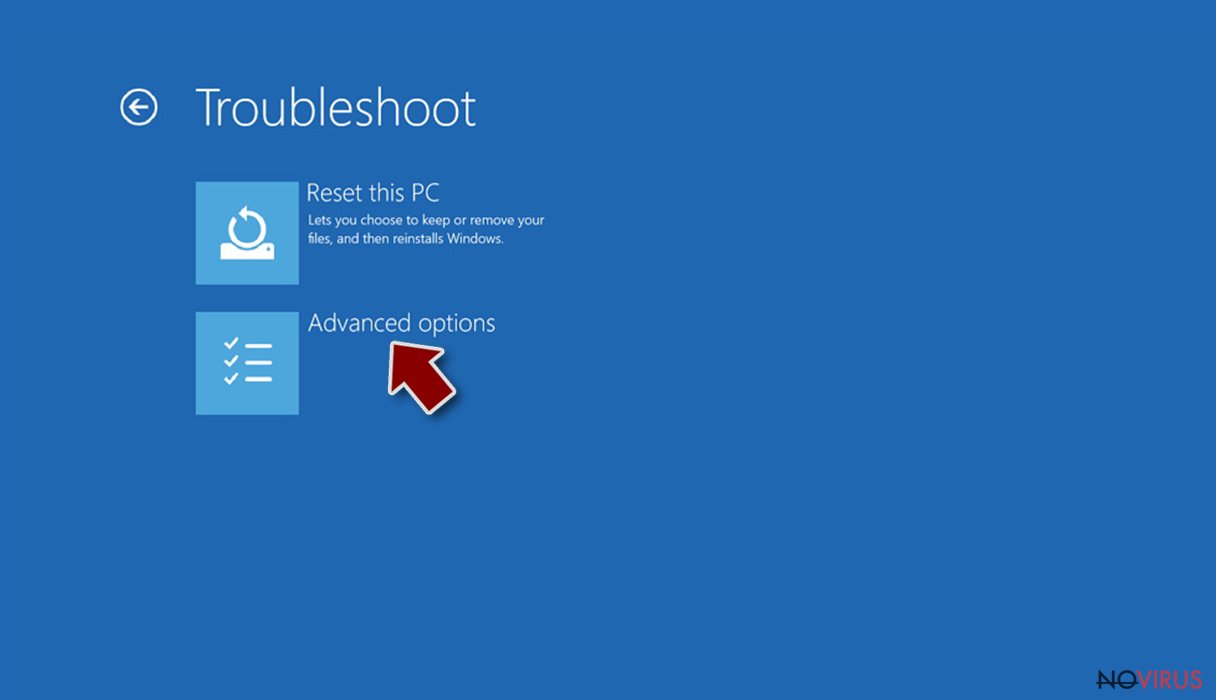
- Select Startup Settings.
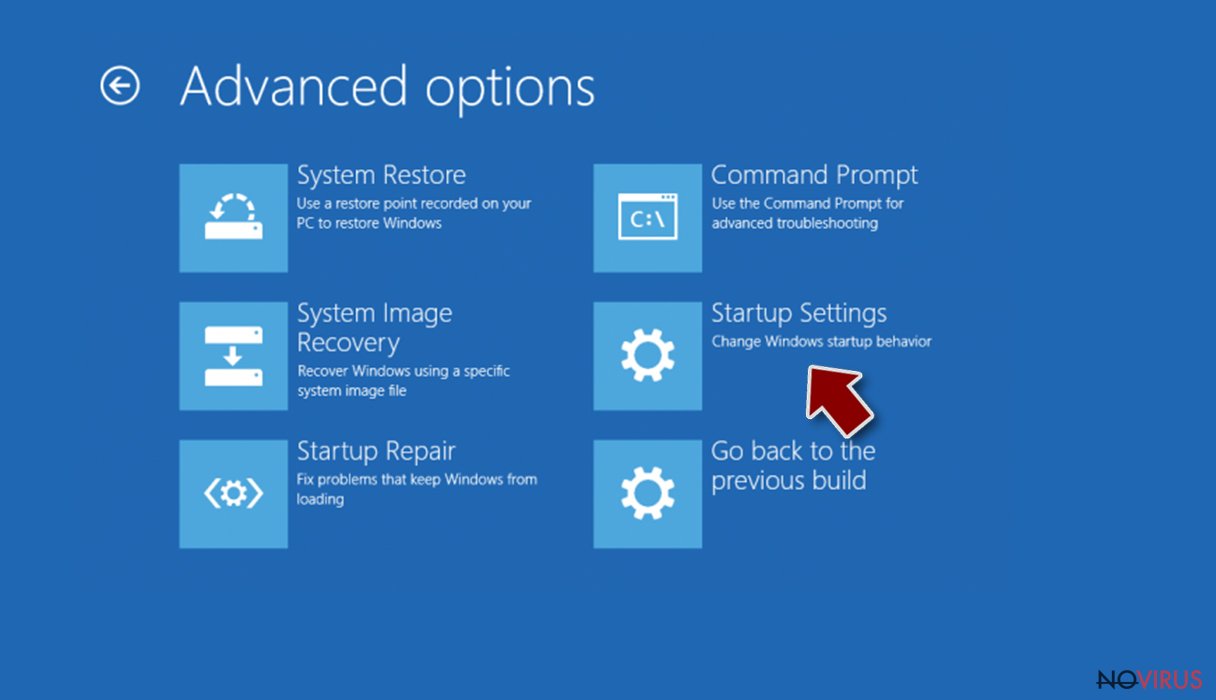
- Press Restart.
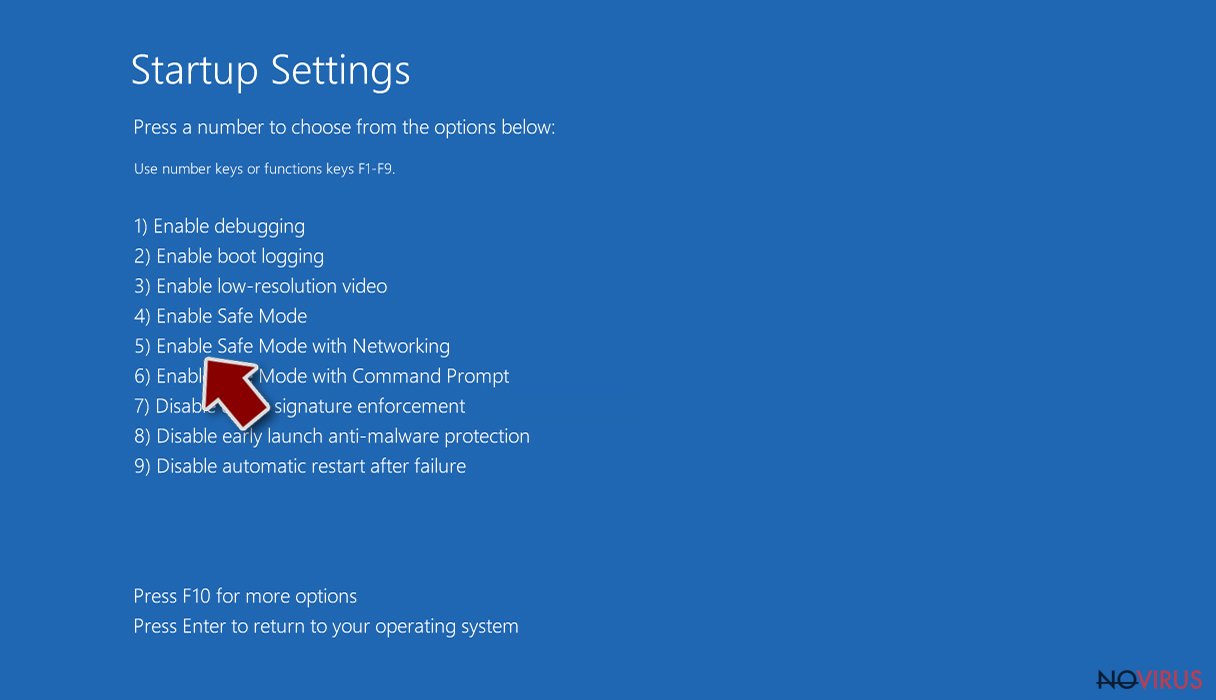
- Choose 5) Enable Safe Mode with Networking.
Step 2. End questionable processes
You can rely on Windows Task Manager that finds all the random processes in the background. When the intruder is triggering any processes, you can shut them down:
- Press Ctrl + Shift + Esc keys to open Windows Task Manager.
- Click on More details.
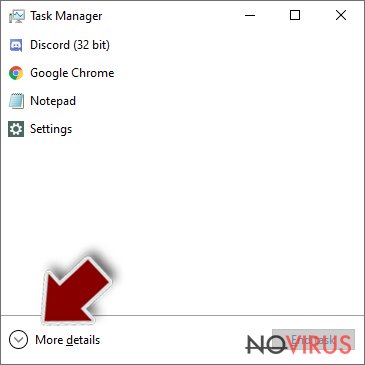
- Scroll down to Background processes.
- Look for anything suspicious.
- Right-click and select Open file location.
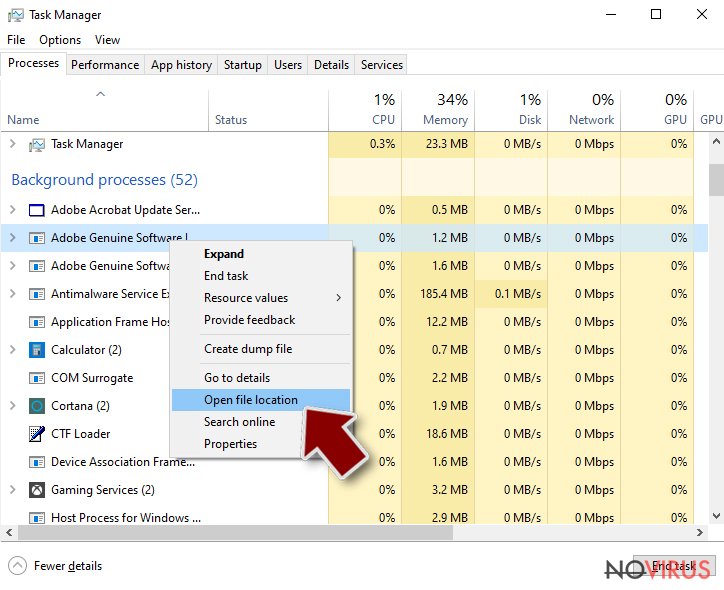
- Go back to the Process tab, right-click and pick End Task.
- Delete the contents of the malicious folder.
Step 3. Check the program in Startup
- Press Ctrl + Shift + Esc on your keyboard again.
- Go to the Startup tab.
- Right-click on the suspicious app and pick Disable.
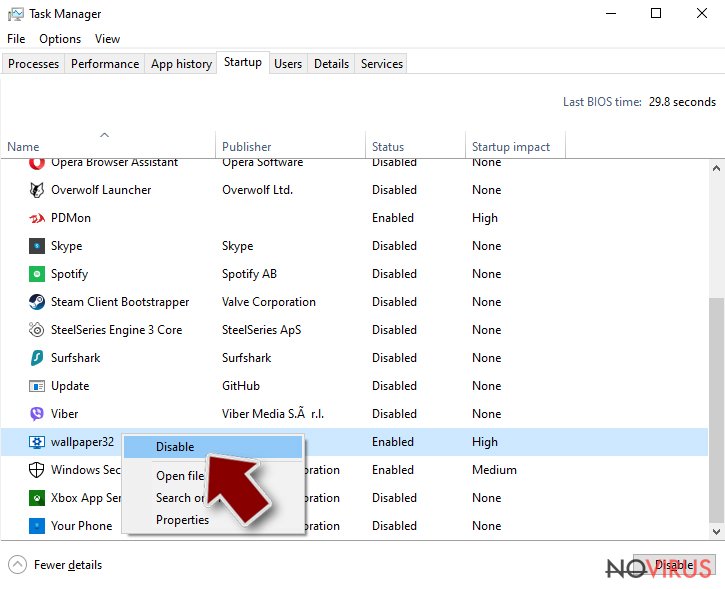
Step 4. Find and eliminate virus files
Data related to the infection can be hidden in various places. Follow the steps and you can find them:
- Type in Disk Cleanup in Windows search and press Enter.
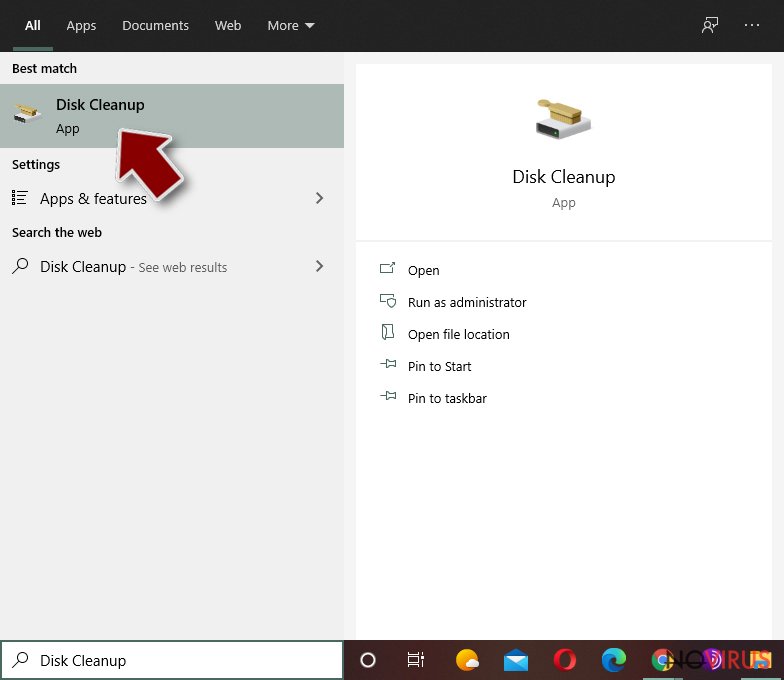
- Select the drive (C: is your main drive by default and is likely to be the one that has malicious files in) you want to clean.
- Scroll through the Files to delete and select the following:
Temporary Internet Files
Downloads
Recycle Bin
Temporary files - Pick Clean up system files.
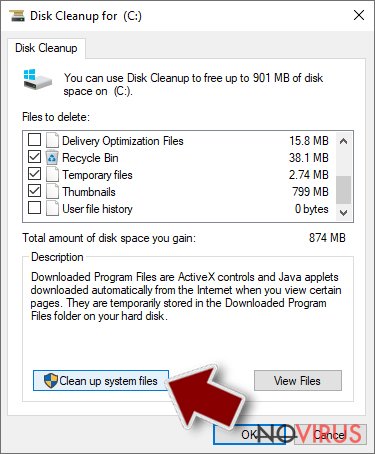
- You can also look for other malicious files hidden in the following folders (type these entries in Windows Search and press Enter):
%AppData%
%LocalAppData%
%ProgramData%
%WinDir%
After you are finished, reboot the PC in normal mode.
Eliminate ODCODC Ransomware using System Restore
ODCODC virus might be stubborn and prevent users from accessing anti-malware tools. However, you can reboot your computer to the Safe Mode with Command Prompt and follow these steps:
-
Step 1: Restart your computer in Safe Mode with Command Prompt
Windows 7 / Vista / XP- Go to Start → Shutdown → Restart → OK.
- As soon as your computer starts, start pressing F8 key repeatedly before the Windows logo shows up.
-
Choose Command Prompt from the list

Windows 10 / Windows 8- Click on the Power button at the Windows login screen, and then press and hold Shift key on your keyboard. Then click Restart.
- Then select Troubleshoot → Advanced options → Startup Settings and click Restart.
-
Once your computer starts, select Enable Safe Mode with Command Prompt from the list of options in Startup Settings.

-
Step 2: Perform a system restore to recover files and settings
-
When the Command Prompt window appears, type in cd restore and press Enter.

-
Then type rstrui.exe and hit Enter..

-
In a new window that shows up, click the Next button and choose a restore point that was created before the infiltration of ODCODC Ransomware and then click on the Next button again.


-
To start system restore, click Yes.

-
When the Command Prompt window appears, type in cd restore and press Enter.
Bonus: Restore your files
Using the tutorial provided above you should be able to eliminate ODCODC Ransomware from the infected device. novirus.uk team has also prepared an in-depth data recovery guide which you will also find above.After ransomware attack, you should not think about paying the ransom. First of all, there’s no guarantee that it will help to decrypt files safely. Bitcoins is just a motivation for cyber criminals to develop more illegal projects. Secondly, ODCODC malware is decryptable, so you can recover your files for free. Additionally, we want to present you three more data recovery solutions. Feel free to try them if ODCODC decryptor does not work for some reason.
There are a couple of methods you can apply to recover data encrypted by ODCODC Ransomware:
Data Recovery Pro – alternative data recovery method
You should try the decryption key and give Data Recovery Pro a try only if some of the files stay encrypted.
- Download Data Recovery Pro;
- Install Data Recovery on your computer following the steps indicated in the software’s Setup;
- Run the program to scan your device for the data encrypted by ODCODC Ransomware ransomware;
- Recover the data.
Windows Previous Versions feature – restore individual files
If System Restore function has been enabled before ODCODC hijack, you can restore individual files by following these steps:
- Right-click on the encrypted document you want to recover;
- Click “Properties” and navigate to “Previous versions” tab;
- In the “Folder versions” section look for the available file copies. Choose the desired version and press “Restore”.
ODCODC Decoder – the free decryption tool
ODCODC Decoder is a tool created for decrypting files specifically encrypted by ODCODC virus. Download it from here.
It is strongly recommended to take precautions and secure your computer from malware attacks. To protect your PC from ODCODC Ransomware and other dangerous viruses, you should install and keep a powerful malware removal tool, for instance, FortectIntego, SpyHunter 5Combo Cleaner or Malwarebytes.
How to prevent from getting ransomware
Prevent the government from spying on you
As there is a growing debate in government about collecting users' data and spying on citizens, you should take a closer look at this issue and find out what shady ways of gathering information can be used to collect information about you. You need to browse anonymously if you want to avoid any government-initiated spying and tracking of information.
You can enjoy secure internet browsing and minimize the risk of intrusion into your system if you use Private Internet Access VPN program. This VPN application creates a virtual private network and provides access to the required data without any content restrictions.
Control government and other third party access to your data and ensure safe web browsing. Even if you do not engage in illegal activities and trust your ISP, we recommend being careful about your security. You should take extra precautions and start using a VPN program.
Recover files damaged by a dangerous malware attack
Despite the fact that there are various circumstances that can cause data to be lost on a system, including accidental deletion, the most common reason people lose photos, documents, videos, and other important data is the infection of malware.
Some malicious programs can delete files and prevent the software from running smoothly. However, there is a greater threat from the dangerous viruses that can encrypt documents, system files, and images. Ransomware-type viruses focus on encrypting data and restricting users’ access to files, so you can permanently lose personal data when you download such a virus to your computer.
The ability to unlock encrypted files is very limited, but some programs have a data recovery feature. In some cases, the Data Recovery Pro program can help recover at least some of the data that has been locked by a virus or other cyber infection.
- ^ Margaret Rouse. RSA algorithm (Rivest-Shamir-Adleman). SearchSecurity. Information Security information, news and tips.
- ^ Lucian Constantin. Ransomware became one of the top threats to enterprises this year. ComputerWorld. It news, careers, business technolgy and reviews.
- ^ Emma Munbodh. This scam email claims you've been caught speeding - and then empties out your bank account. Mirror. The intelligent tabloid.
- ^ Crimeware kit (attack kit, exploit kit). Whatls.com. The tech dictionary and IT encyclopedia.
- ^ Sharon Florentine. 5 tips to stay ahead of ransomware threats. CIO. Latest tech news, analysis, how-to, blogs, and video for IT professionals.







